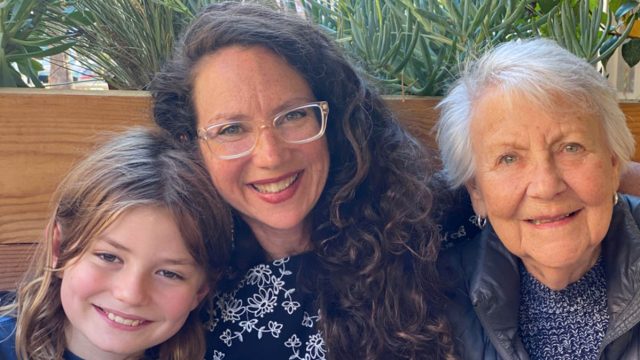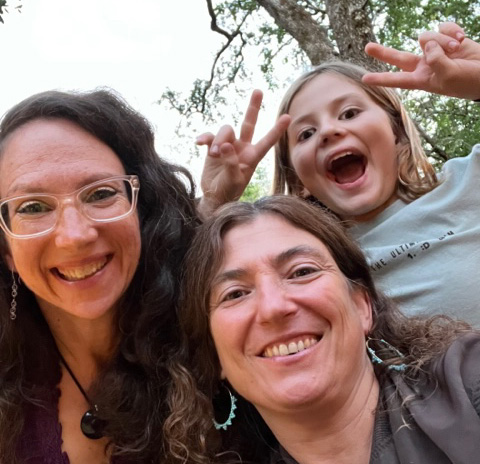
Vanessa Wyser-Pratte: raising her voice to help invisible illness be seen
Vanessa Wyser-Pratte has held many monikers in her life. She spent thirteen years as Ms. Wyser-Pratte to her science students in New York City. For the last 11 years, she has been Super Auntie Vanessa, her favorite title. But her most recent label has been Vanessa the advocate.
The San Francisco Bay area resident was diagnosed with rheumatoid arthritis as a child. Rheumatoid arthritis, or RA, occurs when the immune system attacks healthy cells, often in the joints, and can cause chronic pain, lack of balance, stiffness, and other complications. With early onset cases, like Vanessa’s, whose diagnoses predated many modern treatments, destroyed cartilage and early joint replacements are common. She had a total knee replacement at 26 and eventually, her chronic autoimmune disease forced her to stop working.
“In hindsight, it’s shocking that I tried to hold down a full-time job at all,” said Vanessa, about leaving her teaching job. “There is lots of time on your feet and stress—people who are not teachers may not understand.”
The Centers for Disease Control and Prevention (CDC) reports that arthritis—specifically joint inflammation like that caused by RA—is the most common cause of disability among adults in the U.S. Vanessa is one of those adults, who now relies on Medicare insurance due to her disability.

Around the time Vanessa accepted that she couldn’t continue teaching, her brother was in the process of moving to San Francisco. The draw of family support and a more favorable climate for her joint pain convinced her to move as well. Though she relishes the opportunity to pick her nephew up from school every week, she also struggles with the long-term challenges of managing her illness and living with an invisible disability.
“When you miss 20 or 30 years of being able to earn income, you are at such a disadvantage,” she said. “I know a lot of seniors are struggling and there is struggle everywhere, but I would like this family of diseases to be more visible. It’s an almost insurmountable obstacle for many of us in terms of being financially secure.”
She dedicates much of her life to taking care of her health—between doctor’s appointments, treatment to help manage her pain, like acupuncture, and the search for financial assistance for her prescription medications. Her rheumatologist told her about the PAN Foundation, where she said she has been thankful to receive copay assistance and a transportation grant. Without PAN she said she would likely forgo her medication.
Vanessa recognized that she needed something outside of her health to focus on and looked for a way to use her voice. She did some phone bank volunteering for local politicians, and when she saw an opportunity to advocate with PAN, she said it felt serendipitous.
The $2,000 out-of-pocket prescription cap is a step in the right direction for which I am grateful, but for most of us it is still an unrealistic amount to be asked to spend on prescriptions.
Vanessa Wyser-Pratte
“The PAN Foundation recognizes the complexity of managing chronic diseases. You are attuned to the things that I am talking about.”
“Plus, I have been told I have a very strong voice,” she said.
She joined PAN in a campaign asking Congress to support key Medicare reforms in 2022, including the $2,000 annual cap on out-of-pocket prescription costs. She was thrilled by the reforms enacted through the Inflation Reduction Act—including the cap—but worries that many people will still struggle even after it takes effect in 2025.
“The $2,000 out-of-pocket prescription cap is a step in the right direction for which I am grateful, but for most of us it is still an unrealistic amount to be asked to spend on prescriptions,” she said.
Vanessa is passionate about educating people about healthcare affordability, reforming Medicare, and managing chronic illness from an early age. She says that she usually explains to people that she will forever be stuck at a percentage of her salary from 2007, which is too much to qualify for Medicaid or Extra Help, but her healthcare costs account for at least $10,000 and increase each year. And that total doesn’t account for the costs that fall outside of her insurance coverage, like acupuncture and massage to help with chronic pain or help around the house when it’s too hard to stand.
“We need policies that reflect the loss of years of income. We need policies that reflect the complexity of the diseases,” she said. “You are often looking to fill in the gap and they are often not covered by Medicare.”
This is where PAN steps in.
As the leading cause of disability for adults in the U.S., the need for assistance among RA patients is immense. And unfortunately, because of this high demand, RA financial assistance funds can close quickly. Vanessa said these grants—and the donor support that enables them—are an essential lifeline for people living with RA.
To help implement long-term solutions, she plans to continue to be a vocal advocate for better legislation and reforms for people like her.
She also has some advice for young adults with Medicare who live with chronic illness: find something that moves you and channel your energy there, even if it’s as simple as picking up your nephew from school.
“Being a super auntie is the best thing ever,” she said.
Become an advocate
Help us lower out-of-pocket costs and increase access to healthcare.
Take action
Stand with PAN on a Virtual Day of Action.